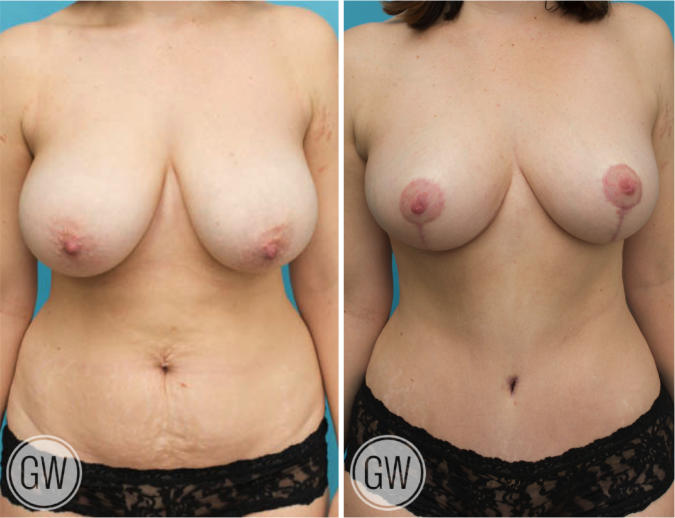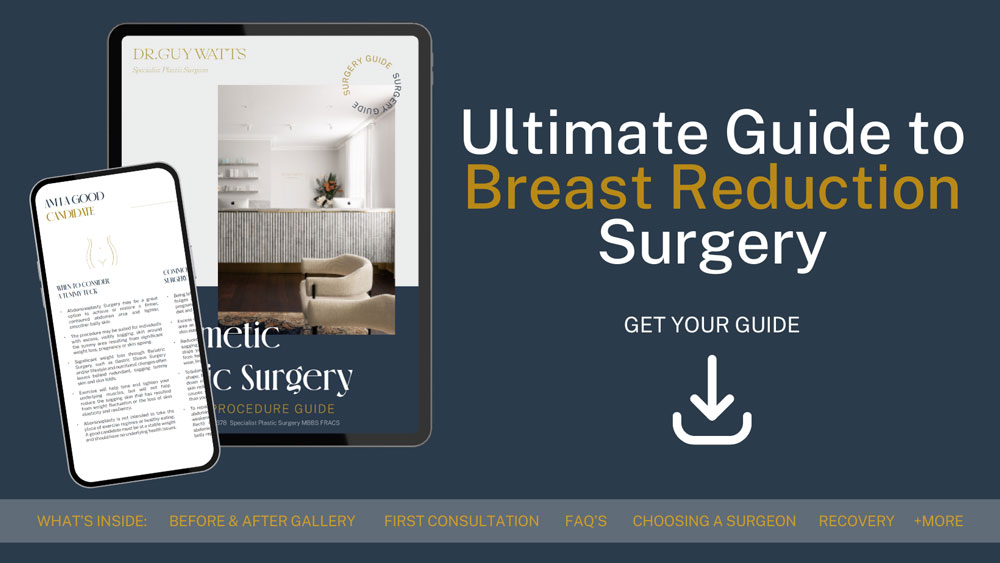
24 May How to Choose the Compression Garments after Breast Reduction
Essential Guide to Selecting Compression Garments Post-Breast Reduction Surgery
Are you trying to determine which compression garment is right for you after your breast reduction surgery? Choosing your post-operative garment is important for a comfort and recovery. Compression garments provide essential support, reduce swelling, and help your breasts heal in their new shape. However, with numerous options available, it can be overwhelming to determine which one is most suitable for you.
Compression garments include a range of specially designed bras, vests, and bodysuits that help manage swelling and promote blood circulation. These items are engineered to provide adequate support without compromising comfort. Wearing them as directed by Dr. Guy Watts can help your recovery and may contribute to the optimal shaping of your breast contours after surgery.
In this blog, Perth Specialist Plastic Surgeon Dr. Guy Watts will walk you through everything you need to know about compression garments after breast reduction surgery. We’ll explore their potential benefits, discuss why they are vital during the recovery process, and provide you with practical tips and considerations to help you make a decision.
Take our quiz, and find out if you are ready for surgery
Overview of Breast Reduction Surgery
Breast reduction surgery, also known as reduction mammoplasty, involves the removal of excess breast fat, glandular tissue, and skin. It aims to alleviate discomfort associated with overly large breasts.
During the procedure, Dr. Guy Watts makes incisions in your breasts, removes some tissue, and reshapes the remaining tissue. The specifics of the procedure can vary, depending on your individual needs and the techniques preferred by Dr. Watts. Post-operative care is integral to your recovery, with compression garments playing an important role in reducing swelling and supporting the altered breast shape.
After surgery, you can expect to feel discomfort and see swelling, both of which are managed effectively with the right compression garments.
The Role of Compression Garments in Recovery
Compression garments serve an important function in your recovery following breast reduction surgery. They help reduce swelling, decrease discomfort, and support the newly shaped breasts.
By applying light, even pressure to the chest area, compression garments facilitate an increase in blood circulation, which can be beneficial for tissue healing and reduction of swelling. They also help in keeping the surgical area in place, preventing the tissues from moving excessively, which could disrupt the healing process. Moreover, these garments can also reduce the risk of fluid build-up and help shape the breasts as they heal.
It is usually recommended to wear compression garments 24 hours a day during the initial weeks after surgery, except when bathing. Dr. Watts will provide specific guidance on how long to wear these garments based on your personal recovery progress. Adherence to these guidelines is vital for achieving optimal healing outcomes.
DOWNLOAD DR WATTS’ GUIDE TO BREAST REDUCTION

Types of Compression Garments Available
There are several types of compression garments available that may be suitable for use after breast reduction surgery. These include compression bras, vests, and custom-fit garments. Each type has specific features designed to meet different needs during the recovery phase.
Compression bras
Compression bras are similar in design to sports bras but are made from stronger materials with less seams to reduce irritation. They usually feature front closures to make them easier to put on and take off when your mobility is restricted after surgery.
Compression vests
Compression vests cover more of the upper body, providing support not only to the breasts but also to the lymphatic drainage areas across the chest and underarms, which is helpful in reducing swelling.
Custom Fit Garments
For those with unique body shapes or specific needs, custom-fit garments might be the most suitable option. These are tailored to fit your exact dimensions, providing precise compression and support tailored to your body. Although they can be more expensive, their customised fit often makes them more comfortable and effective at promoting healing.
Features to Look for in Compression Garments
When choosing a compression garment, there are several important features to consider to make sure they are effective and comfort during your recovery. The material and fabric of the garment should be breathable and offer moisture-wicking properties to keep the skin dry and comfortable. Fabrics with a blend of cotton and spandex are recommended because they provide the necessary elasticity and comfort.
The closure type is another crucial feature. Look for garments with front closures, such as zippers or hook-and-eye closures, which are easier to manage when your range of motion may be limited following surgery. Additionally, adjustable straps or closures can help accommodate the changes in breast size and shape as the swelling decreases over time.
Finally, adjustability in the garment is essential. As your body heals and swelling reduces, the ability to adjust the fit of your garment can be beneficial. This helps make sure the compression remains at an optimal level for effective support and comfort throughout the recovery process.
How to Choose the Right Size
Selecting the size of compression garment is essential to make sure it performs its function without causing discomfort or restricting blood flow. To choose the right size, you must accurately measure your body. Use a soft tape measure to determine the size around your chest, under your breasts, and around your waist if the garment extends to this area.
Consult sizing charts provided by the manufacturer, as sizing can vary between different brands. It’s important to follow these charts closely rather than choosing your usual clothing size because compression garments are designed to fit more snugly than regular clothes.
If you find that standard sizes do not fit well, consider a custom-fit garment. Although more costly, they are made to your specific measurements, providing optimal support and comfort, which can significantly impact your recovery process.
The Importance of Comfort
When recovering from breast reduction surgery, the comfort of your compression garment is essential. While the primary function of these garments is to provide compression, finding a balance where they are not overly restrictive is key. A well-fitting garment will offer enough compression to support healing without causing discomfort or impeding blood circulation.
Choose garments with soft, seamless fabric that does not irritate the skin. Features such as padded straps and a soft inner lining can significantly impact comfort levels. Additionally, you should make sure any zippers or hooks are covered to prevent them from coming into contact with your skin, which can lead to irritation or injury during prolonged use.
It’s also important to consider the garment’s breathability, especially if you’ll be wearing it continuously. Materials that allow air circulation help maintain skin health and comfort, reducing the risk of rashes or infections, which are more common in moist environments.
How Long to Use the Compression Garments
The duration for which you should wear compression garments can vary depending on individual healing rates and the specific advice of Dr. Guy Watts. Generally, it is recommended to wear these garments continuously for the first few weeks after surgery. During this period, they should only be removed for bathing.
As you progress in your recovery, the continuous need for compression may decrease. Dr. Watts might advise you to wear the garments only during the day or reduce usage gradually. It’s important to follow his instructions closely to make sure you heal optimal and avoid complications.
In some cases, prolonged use of compression garments may be recommended, especially if swelling persists or if additional support is needed. Always consult Dr. Guy Watts if you are unsure about the duration of wear appropriate for your specific situation.
Maintaining and Caring for Your Compression Garments
Proper maintenance of your compression garments is important to make sure they remain effective and hygienic throughout your recovery period. Regular washing is crucial, as build-up of sweat and skin cells can lead to skin irritation or infections.
Follow the care instructions provided with your garment closely. Most compression garments should be washed in cold water with mild detergent and air-dried. Avoid using fabric softeners or bleach, as these can break down the fabric’s elasticity and irritate your skin.
If your garment starts to lose its elasticity or loses firmness (which affects its ability provide adequate compression), it may be time to replace it. A well-cared-for garment usually lasts through a full recovery period, but individual needs may vary, and having multiple garments can be useful for maintaining cleanliness and consistent use.
Potential Problems with Compression Garments
Even with careful selection and fitting, some issues might arise with your compression garments. Common problems include issues with fit, discomfort, and signs of poor circulation. Knowing how to address these issues is important for your comfort and health.
If your garment feels too tight or is causing pain, it may be impeding circulation, which is counterproductive to healing. In this case, consult with Dr. Watts to adjust the fit or explore different styles or sizes. A well-fitted garment should feel snug but not painful, and you should be able to breathe and move relatively easily.
Discomfort can often be alleviated by adjusting the straps or closures, or by choosing a garment with different materials. Some women may have sensitive skin that reacts to certain fabrics. If irritation occurs, look for garments labelled hypoallergenic or made from a different fabric blend that might be more suitable for your skin.
Also, if you notice any swelling below the area where the garment ends, redness, or tingling sensations, these could be signs of poor circulation. Consult Dr. Watts immediately if you experience any of these symptoms.
Where to Buy Compression Garments
Once you have had your pre-op with the Surgical Team our preferred garment supplier will contact you directly for a fitting and provide information on how to purchase your garment.
What to Expect When Wearing Compression Garments
In the first week post-surgery, wearing compression garments may feel unusually tight and uncomfortable. This is to be expected, as your body adjusts to the pressure and the initial swelling post-operation. Over time, as the swelling decreases, the garment will feel more comfortable.
It’s important to wear the garment continuously as advised by Dr. Guy Watts. While it may be tempting to remove it if discomfort occurs, continuous wear is essential for effective healing. Over the weeks, as you adjust, the garment should become part of your routine, and you may even forget you are wearing it.
Adjusting to daily wear involves being mindful of how the garment feels throughout the day and making small adjustments if needed. Regularly check the fit and feel of the garment and make sure it is not causing any new discomfort or restricting your movements excessively.
FAQs about How to Choose the Compression Garments after Breast Reduction
Can I switch between different types of compression garments during my recovery?
- Yes, it’s possible to switch between different types of compression garments based on your healing stage and comfort needs.
- For instance, you might start with a more robust compression vest immediately after surgery and switch to a lighter compression bra as your healing progresses.
- Always consult with Dr Watts before making any changes to make sure it suits your specific recovery needs.
How do I know if my compression garment is too big?
- A compression garment that is too big may not provide sufficient support and could lead to increased swelling or a delay in the healing process.
- Signs that your garment may be too big include the fabric easily moving away from your body or bunching up, and not feeling any pressure around the surgery area.
- If you suspect your garment is too big consult with a specialist to get refitted or try a smaller size.
Is it necessary to have more than one compression garment?
- It is advisable to have at least two compression garments so you can wear one while the other is being washed.
- This makes sure you have continuous compression support, which is essential for optimal healing.
- Having multiple garments also helps maintain the integrity and elasticity of each garment, as they will undergo less wear and tear.
How long does a typical compression garment last before needing replacement?
- The lifespan of a compression garment depends on several factors, including how often it’s worn and washed, the integrity of the material, and how well it’s maintained. Generally, a compression garment can last several months with proper care.
- Regularly inspect your garment for signs of wear, such as stretched fabric or unravelling seams, and replace it if it no longer provides adequate compression.
Can wearing a compression garment affect my skin health?
- While compression garments are designed to support your healing, they can sometimes affect skin health, particularly if worn too tightly or if made from non-breathable materials.
- To reduce any negative effects on your skin, choose garments made from breathable fabrics, make sure the fit properly to avoid chafing, and maintain good hygiene by regularly cleaning the garment and your skin.
Further Reading about Breast Reduction with Dr. Guy Watts
- Read more about Top 10 Methods to Reduce Scars after Breast Reduction Surgery
- Read more about What Are Typical Symptoms to Experience During Breast Reduction Recovery
- Read more about Options for Heavy Breasts – Breast Reduction
- Read more about Will Medicare Cover My Breast Reduction?
- Read more about Exercising after Breast Reduction
Medical References about Compression Garments
- Compression Garments for Medical Therapy and Sports – NCBI
- Putting the Squeeze on Compression Garments – NCBI
- Benefits of Compression Therapy – WebMD
- Compression Therapy: Types and Benefits – Cleveland Clinic
- Effect of Compression Garments on the Ventilatory Function – Oxford Academy
About Dr. Guy Watts – MED0001539378
FRACS (Plas) – Specialist Plastic Surgeon In Perth WA
Dr. Guy Watts is a Specialist Plastic Surgeon (AHPRA MED0001539378) with an extensive career that spans across renowned plastic surgery clinics worldwide. His experience has been honed through invaluable experiences at esteemed establishments such as the New York Eye and Ear Infirmary and the renowned Pitanguy Clinic in Brazil.
Having collaborated with the foremost cosmetic plastic surgeons on a global scale, Dr. Watts has chosen to return to Perth after a 17-year journey of intensive training and invaluable professional experience to bring the latest practices and technology in cosmetic plastic surgery to his patients.
Dr. Watts is a Fellow of the Royal Australasian College of Surgeons (FRACS) and a Member of the Australian Society of Plastic Surgeons (ASPS), Australasian Society of Aesthetic Plastic Surgeons (ASAPS) and the International Society of Aesthetic Plastic Surgeons (ISAPS).
Read about the potential Risks and Complications of Surgery
Read the Patient Information and Resources
About CLINISPA
Clinispa is Dr Watts’ bespoke medical clinic performing Cosmetic Aesthetic treatments. At Clinispa, we offer advanced clinical treatments in a luxurious and calming environment, tailored to support your skin’s health and appearance.
Clinispa aesthetic services are performed by Dr Guy Watts’ nursing professionals, who have a passion for and solid understanding of facial aesthetics.
All Clinispa clients are considered individually, with a personalised treatment plan consisting of advanced scientific approaches to cosmetic aesthetics. We incorporate innovative technologies in conjunction with superiorly formulated skin care.
For more information about the full range of Clinispa Aesthetic of Cosmetic Treatments visit the Clinispa website








Sorry, the comment form is closed at this time.